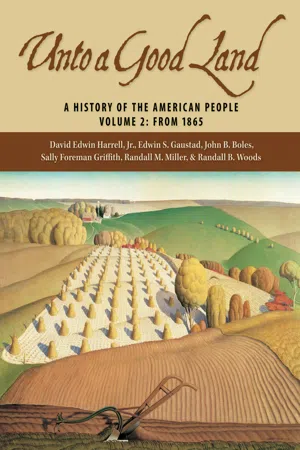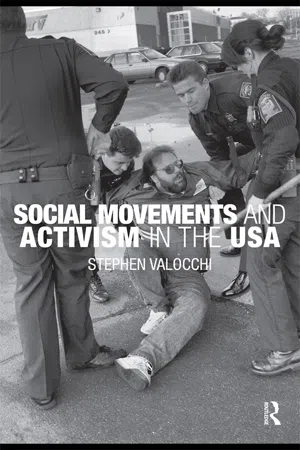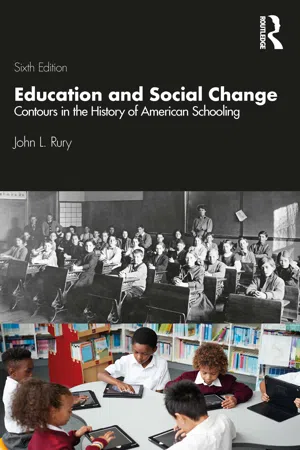History
Successes and Failures of Progressivism
The successes of progressivism in the early 20th century included the implementation of labor laws, women's suffrage, and the regulation of monopolies. However, progressivism also faced failures such as the limited impact on racial equality and the inability to fully address urban poverty. Overall, progressivism made significant strides in reforming American society but fell short in achieving comprehensive social and economic change.
Written by Perlego with AI-assistance
Related key terms
3 Key excerpts on "Successes and Failures of Progressivism"
- eBook - ePub
Unto a Good Land
A History of the American People, Volume 2: From 1865
- David Edwin Harrell, Edwin S. Gaustad, John B. Boles, Sally Foreman Griffith(Authors)
- 2005(Publication Date)
- Eerdmans(Publisher)
24
Progressivism in American Politics, 1901 to World War I
Chapter 24 at a Glance The Core of the Progressive Agenda The Urban Social Justice Movement Saving the WASP Empire Local and State Political Reform Reorganizing American Cities Progressivism in the States Electoral Reform—Democratic and Undemocratic States Provide Models for Progressive Legislation Theodore Roosevelt and the Selling of National Progressivism Theodore Roosevelt Takes Center Stage The Extension of Regulation and Trustbusting Political Victory and the Square Deal A Beginning for Conservation Roosevelt Drifts to the Left Competing Progressive Visions Roosevelt Picks His Successor Taft Alienates the Progressives The Rift between Roosevelt and Taft The Election of 1912 Wilsonian Progressivism The Scholar President Congress Backs the President Expanding the New Freedom Conclusion: The Legacy of Political ProgressivismT HE ANXIETIES CAUSED by rapid social and economic change at the turn of the century defined the Progressive Era as a time of causes and crusades. The reform sentiment of the period took on added significance because most progressives looked to government to restore the American dream, and they relished political combat. The governmental reforms of the Gilded Age, including civil service reform and the growing professionalization of the Washington bureaucracy, had set the stage for the progressive movement, and the election of 1896 had provided an agenda for the progressive presidents of the early twentieth century—Theodore Roosevelt, William Howard Taft, and Woodrow Wilson. Progressives backed a broad array of social, economic, and political reforms; no one person was likely to embrace all of them. The federal government enacted the era’s most far-reaching legislation, but progressives won their first political successes at the local and state levels.Nationally, the Progressive Era witnessed a renaissance of presidential leadership, conspicuously lacking in the Gilded Age. Roosevelt and Wilson are generally ranked among the nation’s greatest chief executives, and Taft was a competent (if politically clumsy) and somewhat underrated president. Surrounding these presidents were a colorful and vigorous cast of political characters whose thought and actions helped shape modern America. - eBook - ePub
- Stephen Valocchi(Author)
- 2009(Publication Date)
- Routledge(Publisher)
Third, these groups utilized many pre-existing organizations to turn private troubles into public issues and social action. Organizations in the city, such as the churches, schools, unions, ethnic and racial groups, or social service organizations provided the resources and ideas that moved people to act in more progressive ways than intended by the mandates of these organizations. But these same organizations were also products of a political culture in the city that stressed cooperation over conflict and service over activism. This tension shaped the kinds of progressive activism that emerged and proved successful in the city.Fourth, these groups also took advantage of some favorable political opportunities. Chief among the political opportunities turning private troubles into public issues was the Depression era economic instabilities and the 1960s-era national social movements. The Depression created an auspicious organizing environment for labor unions. The 1960s protest wave spawned local service and advocacy organizations as well as local versions of national insurgencies. Fifth, the response to that collective action was shaped by the “velvet glove” of benevolent control in the civic sphere and the “iron fist” of corporate resistance in the economic sphere, although clearly the former form of control was more deeply embedded in the political culture. Social movement organizations embodied both moderate and militant postures in their strategies and goals but, owing to the periodic benevolence of elites and their control over resources, these organizations veered decidedly in the direction of moderation. Seventh and finally, the urban context itself, particularly the symbolic and economic uses of architecture and land helped shape the specific nature of social movement demands. Many concepts from social movement scholarship are necessary to explain this rich history of Hartford’s progressive activism.This overview also returns us to C. Wright Mills’ exhortation about history and biography and about large social processes and individual life circumstances. It also illustrates the constraints under which current activists operate: the conditions “not of one’s choosing,” again paraphrasing Karl Marx. The progressive activists working in the city in the early part of the twenty-first century are products of this context and conditions in manifold ways but, as we hear in the following chapters, they are also active agents who change this context and these conditions. - eBook - ePub
Education and Social Change
Contours in the History of American Schooling
- John L. Rury(Author)
- 2019(Publication Date)
- Routledge(Publisher)
Education and social reform, however, did not dictate the basic tenor of the age. Rather, forces of industrialization and urban growth defined it, factors that had spurred change in earlier times. The difference was magnitude and pace. By the 20th century, the degree of industrial development and urbanization had reached levels scarcely imaginable decades earlier. Corporate enterprises reached a mammoth scale, serving far-flung markets with new technologies designed for mass production. Industrial expansion accelerated, boosting international trade and migration. The country was losing its pastoral character in the wake of incipient globalization (O’Rourke & Williamson, 2001). Cities swelled as millions of immigrants arrived to seek jobs. Cultural diversity became even more pronounced and dozens of languages could be heard on the streets. American society seemed to be rapidly changing in ways difficult to fathom (Hays, 1957/1995; Higgs, 1971; Rodgers, 1998). This became a source of new anxieties, and eventually a focal point for reform. As noted by historian Robert Wiebe, a “search for order” became emblematic of a new stage in American history (Wiebe, 1967).Progressivism, in short, represented a response to this new era of industrial development and urban growth. In the words of historian Lawrence Cremin, it was “a vast humanitarian effort to apply the promise of American life… to the puzzling new urban-industrial civilization that came into being during the latter half of the 19th century” (Cremin, 1961). Whether or not it was entirely humane, there can be little doubt that education was an integral part of the reform impulse. It was an age that called for schools to serve a multitude of purposes. As society became more complex and variegated, so did the educational system. But before considering that, it is instructive to consider some of the challenges of growing up in this new milieu.FOCAL POINT: COMING OF AGE IN URBAN AMERICA
Needless to say, the social environment of big cities had a profound effect on children. Among other things, many believed it loosened traditional sources of authority that had long managed their behavior. Urban growth brought freedom and open-mindedness, and youth were allowed greater latitude in conducting themselves. These changes were hardly abrupt, as prevailing social and cultural norms still exerted considerable influence. But novelty was coming into fashion, and it was especially conspicuous among the young in urban settings.
Index pages curate the most relevant extracts from our library of academic textbooks. They’ve been created using an in-house natural language model (NLM), each adding context and meaning to key research topics.


